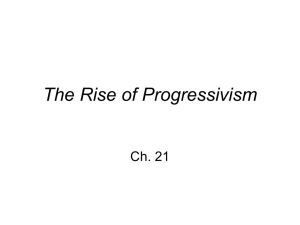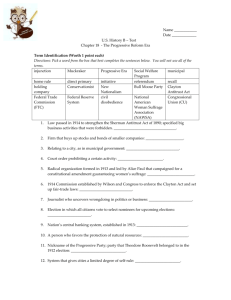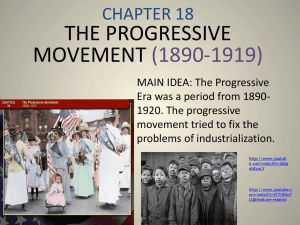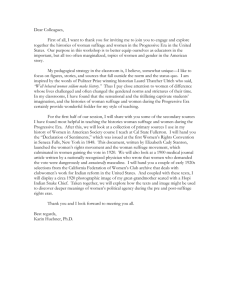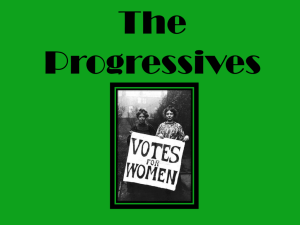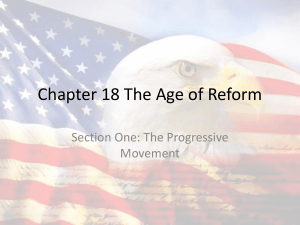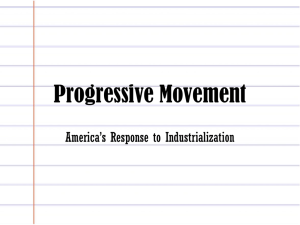Ch 21 The Rise of Progressivism
advertisement
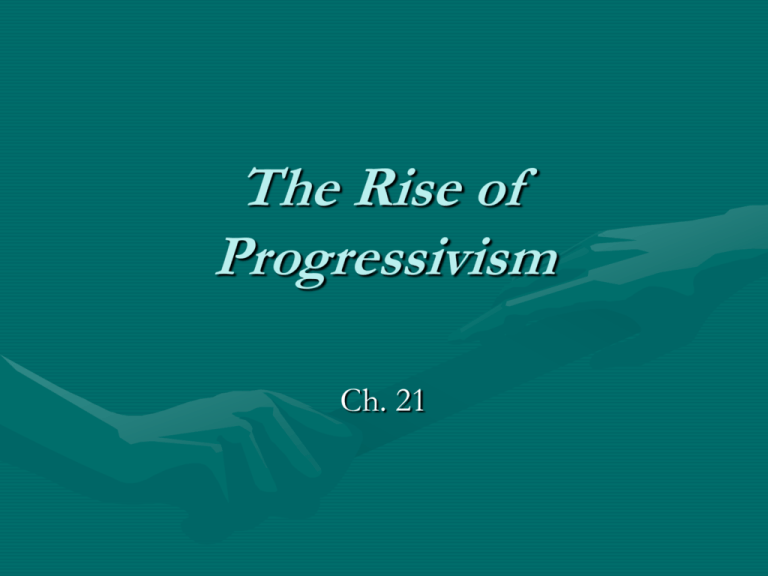
The Rise of Progressivism Ch. 21 I. The Progressive Impulse • Direct, purposeful human intervention in social and economic affairs was essential to ordering and bettering society. Laissez faire and Social Darwinism looked upon as inefficient to maintain order. • • Varieties of Progressivism Progressives often disagreed – Spirit of “Anti-monopoly” • • – no longer just populist spread to middle class Social cohesion • • • individuals not autonomous, but rather part of a web welfare of individual dependent upon welfare of society concern now “victims” of industrialization – Faith in knowledge • • – Increasing the role of government • • • – some looked to knowledge for order and efficiency others looked to it as a means of making society more equitable and humane modern life too complex to be run by party bosses enhanced institutions new breed of leaders Incompatible Philosophies? The Muckrakers – – – term coined by TR in accusation that they were raking up muck crusading journalists whose goal was to direct public attention toward social, economic, and political injustices often times reported scandal, corruption and injustice to public view Muckrakers – Individuals • • • Charles F. Adams (1860s) = railroad Ida Tarbell (1904) = Standard Oil Lincoln Steffens = Political Machines Charles F. Adams Ida Tarbell The History of the Standard Oil Company Lincoln Steffens Shame of the Cities Chapters of Erie – Other areas of influence • • – – Organizations: labor unions, governments, corporations Social Issues: prostitution, immigrant ghettos, child labor and family disorganization, conservation of natural resources, subjugation of women, oppression of blacks Reached peak of influence in first decade of the 20th century Inspired Americans to take action and echoed progressive ideals The Social Gospel – – – Social outrage combined with a humanitarian sense of social responsibility helped produce many reformers who were committed to social justice “Social Gospel” movement came to power in the early 20th century Started with Protestantism, but soon found a following in Catholicism and Judaism – Salvation Army • began in England, but spread to the US • example of fusion of religion with reform • 3,000 officers / 20,000 privates • committed to offering both material aid and spiritual service to the poor – Individual contributions • Charles Sheldon’s In His Steps: 15 million copies • Walter Rauschenbusch: Darwinism not survival of the fittest, but rather all should work to ensure a humanitarian evolution into the social fabric • Pope Leo XIII: Rerum Novarum “New Things” • Father John A. Ryan The Settlement House Movement – – Where Social Darwinists (William Graham Sumner) argued that people’s fortunes reflected their inherent “fitness”, progressives disagreed… Ignorance, poverty, even criminality were not the result of inherent moral or genetic failings they were, rather, the effects of an unhealthy environment. Settlement houses build in response to growing public concern over poor immigrant neighborhoods (Jacob Riis) The Settlement House Movement Continued – Hull House (1889), Chicago • Jane Addams • Became a model for more than 400 similar institutions • Helped immigrant families adapt to the language and customs of their new country • Middle class had a responsibility to assist and educate immigrants The Settlement House Movement Continued – Role of college women • • • – provided assistance settlement houses were an “appropriate” place for young, single women to live Eleanor Roosevelt The Birth of Social Work • • connection to University of Chicago compassion for poor combined with values of progressivism The Allure of Expertise – – – – Progressives placed high value on knowledge and expertise Non-scientific problems could be solved with science Belief that well designed bureaucracies could create the stability and order America needed Whereas S.Darwinism sought to justify the current system, these progressive intellectuals sought to create a new society • – Thorstein Velben: social scientist who was critical of industrial tycoons Pros and cons… where progressives disagree • • Scientific Management and Taylorism Social science and inquiry The Professions – Birth of a new middle class • • – American Medical Association (1901) • • – – – – high value on education and individual accomplishment establishment of modern professions Called for strict, scientific standards John Hopkins (1893) training and research Professional Bar Associations (1916) National Association of Manufactures (1895) United States Chamber of Commerce (1912) Some professionals used admission requirements to exclude women and minorities Women and Professions – – – – Most women were excluded from most of the emerging professions, but many did find ways to enter professional careers 1900 5% of all physicians were female… a proportion that remained unchanged until the 1960s Settlement houses and social work as “appropriate” Teaching: 2/3 of all grammar school teachers were women Women and Professions Continued – Nursing in the post-Civil War era gains credibility – Librarians – the “women professions” common traits with progressivism in that they established a professional identity – differed in that they had a vaguely “domestic” or “helping” image Women and Reform The progressive era represented both an expansion of women’s separate sphere and a confirmation of it The “New Woman” • housework taking up less time of the day – income-producing work leaving the home and going to the factory or office – technological innovations: running water, electricity and household appliances reduced housework (higher standard of cleanliness) – result is that women were looking for activities outside of the home • Less Children and longer lives = more time alive without children around The “New Woman” Continued – “Our failures marry” • • • • • many women believe that only by remaining single could they play the roles they envisioned in the public world 10% of all women never married in the last decades of the 19th century… high proportion of them were middle class Jane Addams and Lillian Ward = settlement house movement Francis Willard = temperance movement Anna Howard Shaw = suffrage movement The “New Woman” Continued Again – – “Boston Marriages” in secret Divorce rates rise • • – The role of higher education and women’s colleges • • – 1880 = 1:21 1916 = 1:9 increased literacy and social understanding creation and establishment of female communities Un-definable yet shifting identity of woman both defined and limited their public activities The Clubwoman – large network of women’s associations grew rapidly between 1880s and 1890s – became the vanguard of many important reforms – formed to give women an outlet for intellectual energies – General Federation of Women’s Clubs • • 1882: 100,000 members / 500 clubs 1917: 1 million members Clubwoman Continued – In the early half of the twentieth century focus shifts to social betterment – Many women were from wealthy families – African American women formed clubs of their own • • • modeled their white counterparts took stands on lynching segregation The Clubwoman Continued Again – Few women actually believed that traditional gender roles were “exploitive and obsolete” (Charlotte Perkins Gilman 1898) – Much of what they did was uncontroversial • • • planting trees supporting schools, libraries and settlement houses building hospitals and parks … and once again. – Some of what they did was controversial • • • • • • • • important force is passing state and federal laws against child labor established gov’t inspection at the workplace regulated food and drug industries reformed policy against the Indian tribes applied new standards to urban housing outlawed the manufacture of alcohol “mother’s pensions” which became absorbed into Social Security 1912 Children’s Bureau in the Labor Department And Again – Alliances formed between women’s groups • • – Women’s Trade Union League 1903 Raised money to support strikes and bail women out of jail Early success depended on male interest • • “maternal” character but reflected contemporary ideas about the natural inclinations of women Woman Suffrage Considered the greatest movement during the progressive era… one of the greatest in American history Why was it considered “radical”? • rationale some supporters used to advance it – – • Popular belief was that men and women also believed in separate spheres – – • “natural rights” women have same right as men Elizabeth Cady Stanton woman’s role as “mother, wife, sister and daughter” was “incidental” to her larger role in society woman’s foremost role was as wives and mothers powerful anti-suffrage movement emerged organized by men with the support of some women anti-suffrage newspapers, rallies, petitions and legislatures How did the tide turn? • suffragists became better organized – • Anna Howard Shaw and Carrie Chapman Catt increased membership in the National American Woman Suffrage Association from 13,000 in 1893 to 2 million in 1917 Leaders began to justify suffrage in “safer” less threatening ways – – women’s suffrage would not challenge separate spheres would allow women to bring their separate and distinct virtues into a corrupt political sphere How did the tide turn? Continued • Connection to other issues – – • • temperance movement World War I Less optimistic reason: If immigrants and black males could vote, “well born” women should be allowed to vote too Supporters played both ends – – radicals continued to support, working class, immigrants and blacks Middle class also supported because of connection to other issues Legislative Process • The West leads the way • • • • • 1910 Washington becomes the first state in 14 years to extend suffrage to women California would follow a year later 4 more western states after that not many Catholic communities in the region East gets caught up – – – Temperance issue: Catholics v. Protestants 1913 Illinois first state East of Mississippi River to grant women suffrage 1917/1918: New York and Michigan, two of the most populous states in the Union Legislative Process Continued • 1920: 19th Amendment guaranteed the political rights to women throughout the nation Feminist Divisions • – – One side: Alice Paul wanted a constitutional amendment that would provide legal protection for the rights of women and would prohibit discrimination on t he basis of sex, Equal Rights Amendment Other side: Jane Addams, Florence Kelley, Carrie Chapman Catt: political compromise the only way to go at this time
